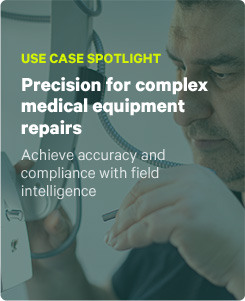In a previous blog, we covered forms automation and its benefits for businesses. We emphasized data collection and management’s critical role in insightful decision-making and organizational agility. This blog will look at forms with workflows and their role in the field service equation.
We’ll focus on what they are, how they move data between systems, and how technicians use them to solve challenges in the field, provide excellent customer experiences, and address changing regulatory and compliance laws.
What is a field service workflow?
A “workflow” is a combination of actions or steps taken to achieve a particular goal. Let’s look at a series of inspection tasks, for example.
First, the inspector must retrieve the form. After recording the field data, they must get it into a back-office system for processing. Then, the data has to be compiled and sent out to the client with proof of service. When combined, these actions comprise one workflow.
As you might guess, doing each step on its own is a massive waste of resources. Instead, forms workflow software makes sharing and transferring data accessible. With just one form, the inspector can automatically get all the information into the system and to the customer.
Forms with workflows and field service operations
To understand these forms with workflows, let’s look at the received and sent information.
On the receiving end, engineers receive information that helps them do their job safely and effectively. Along with the forms that allow them to standardize and record tasks, they can receive data about historical issues and site readiness. Not only does this reduce waste and confusion, but it also cuts down on fuel costs and non-productive time. In that way, these workflows can drive effectiveness on-site and before the engineer even arrives.
After the job is complete, engineers typically send information from the field about tasks done, issues found, time spent, and parts used. They can use this information to fill out work orders, quotes, part requests, and service schedules. By using a workflow with dispatch and progress alerts, companies can automatically trigger actions to help save time, avoid delays, and prevent errors.
Ultimately, it’s easier for engineers to use their expertise to solve problems when they don’t have to scramble for information or try to relay information about work that’s already been done.
Forms with workflows and customer value
Today, delivering value to customers as a differentiator is a constant imperative among contemporary field service organizations. Because of this, they need complete data visibility over their assets and field technicians to support their operations and give their customers a truly unique experience, as seen in the customer impact report survey.
Primarily, workflows help streamline service delivery. Increased visibility enables task and resource prioritization, allowing customers to receive the timeliest response to their needs. Field service workflows also provide data that enables the organization to gather insights to help the business respond quicker and make decisions that will help them solve problems better.
Conclusion
Today, field service organizations have many different data layers to manage to deliver services effectively. Whether it’s information about a customer, an asset, or a job site, it’s critical to access and utilize this data quickly and accurately.
By using the power of forms with workflows to process, manage, and monitor data, organizations can ensure that it goes to internal stakeholders, customers, and regulators. It is also used for business-critical insights that help the organization respond to changing service requirements with unparalleled responsiveness.
Are you interested in harnessing the power of field service workflows? Contact us today for a demo.




